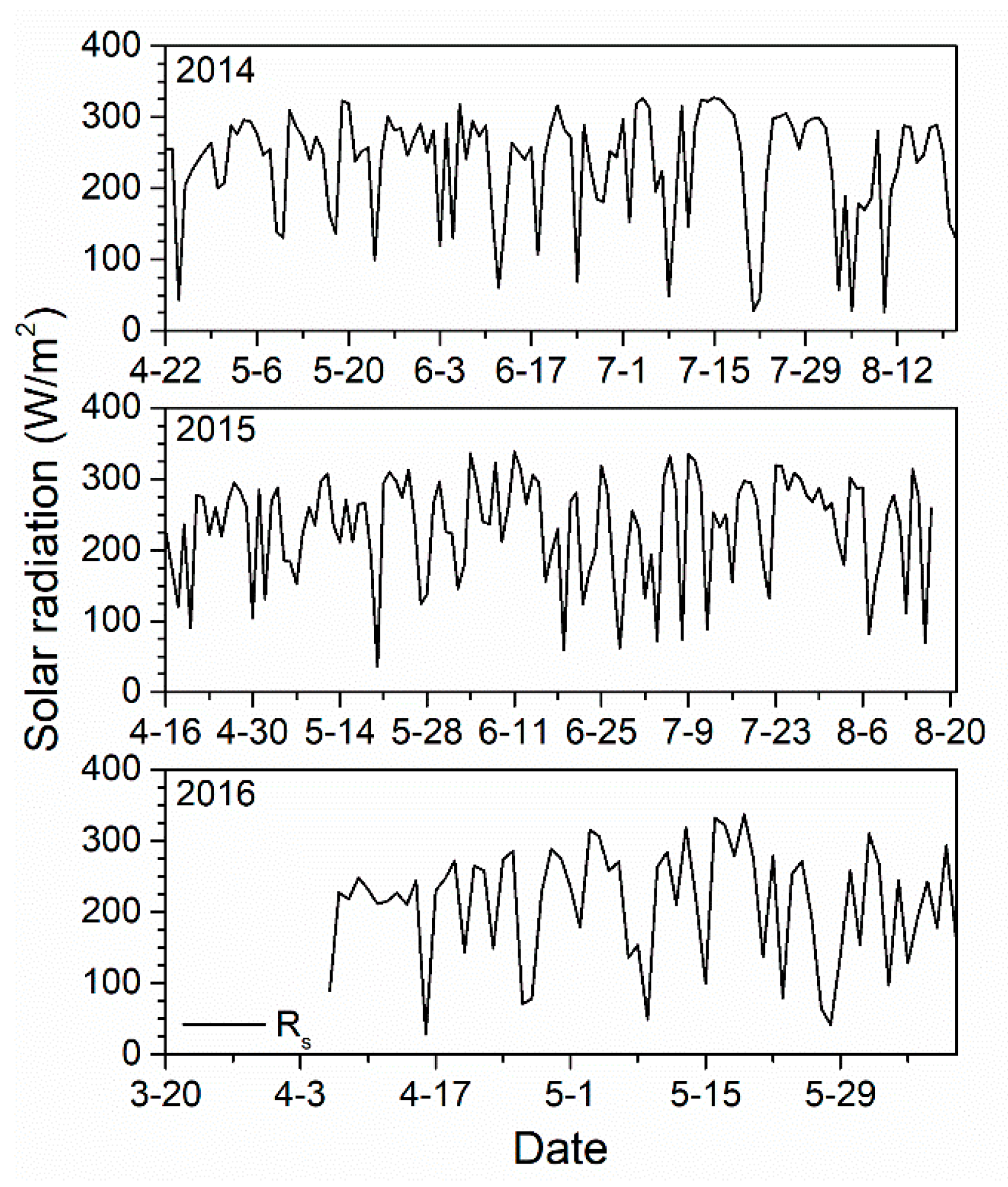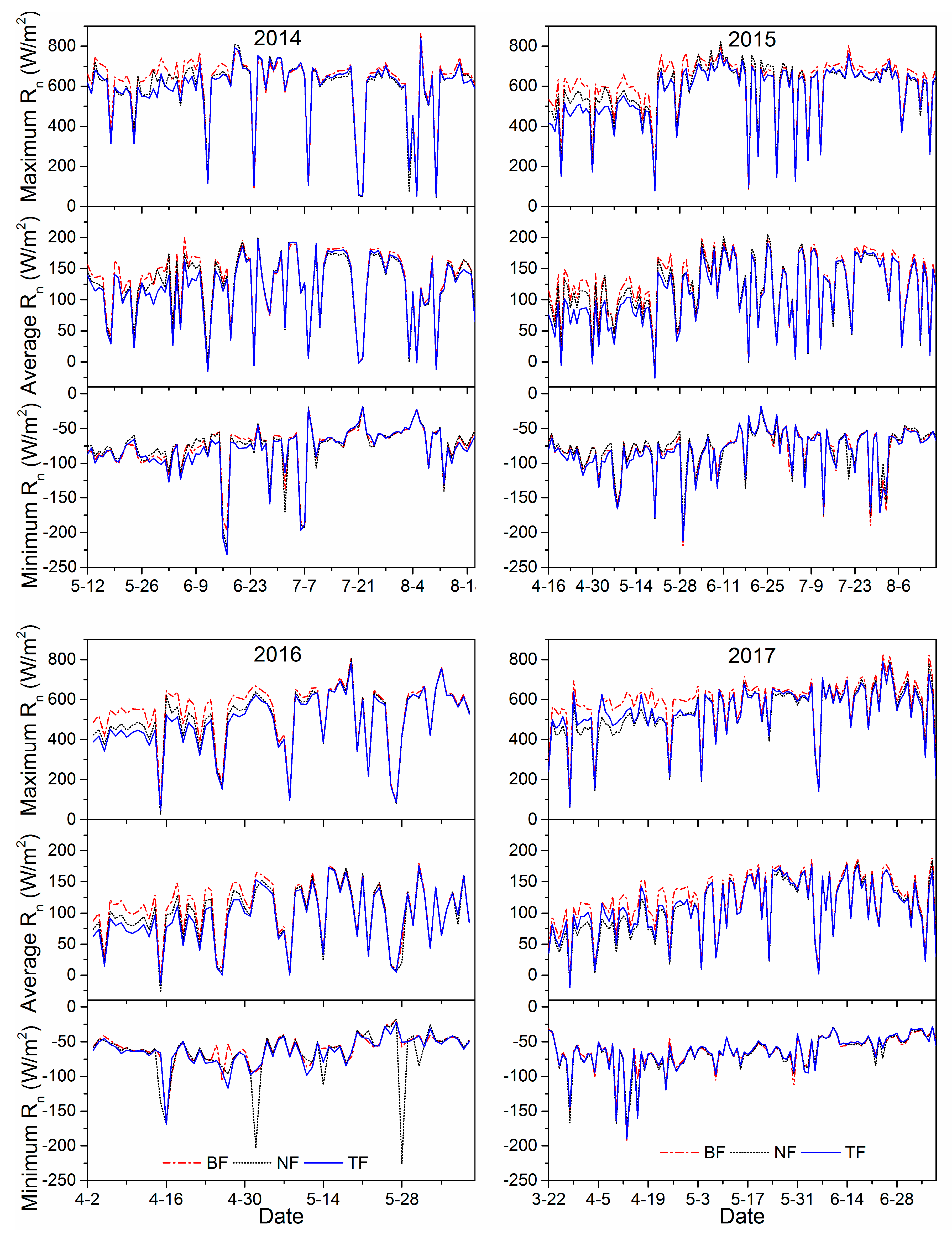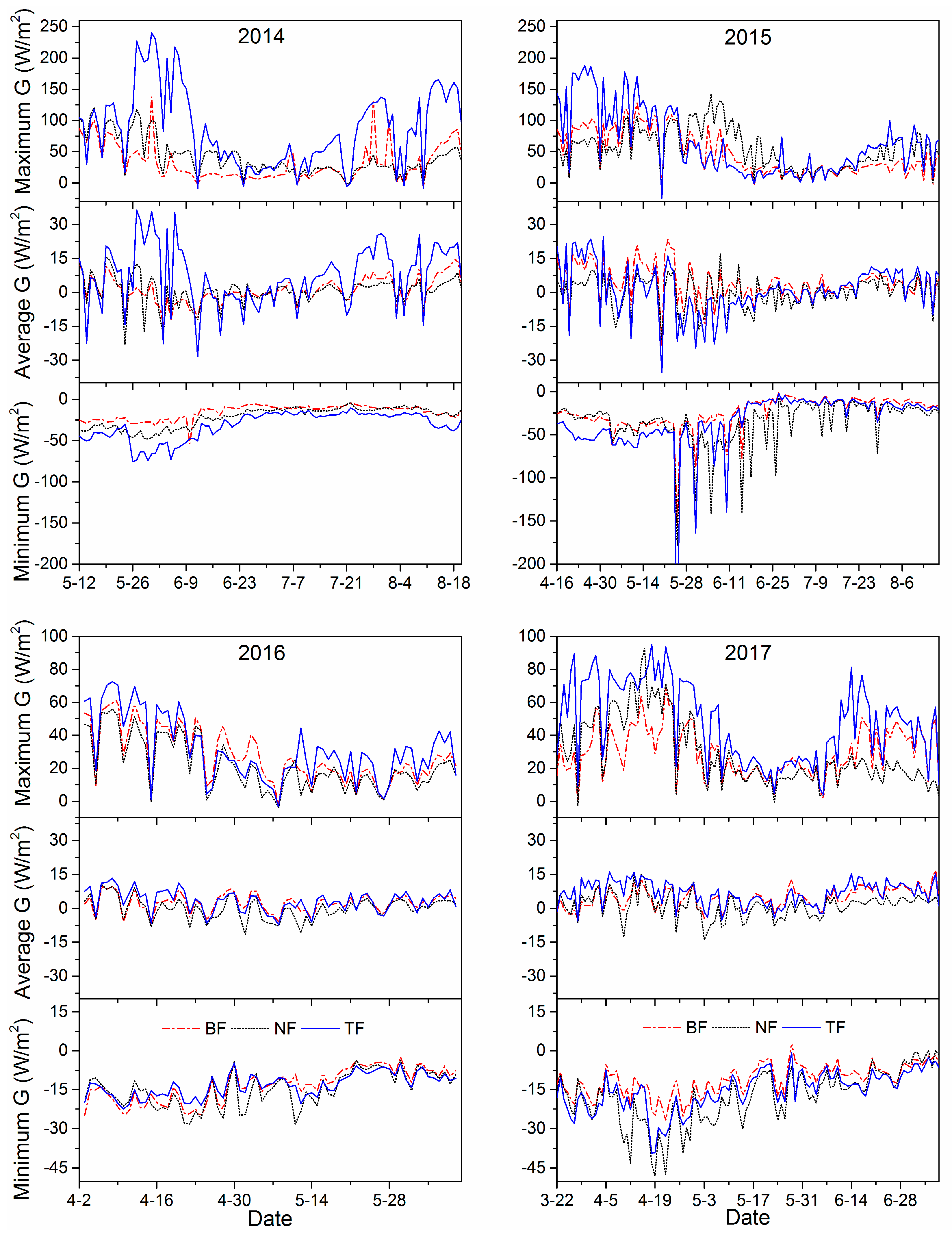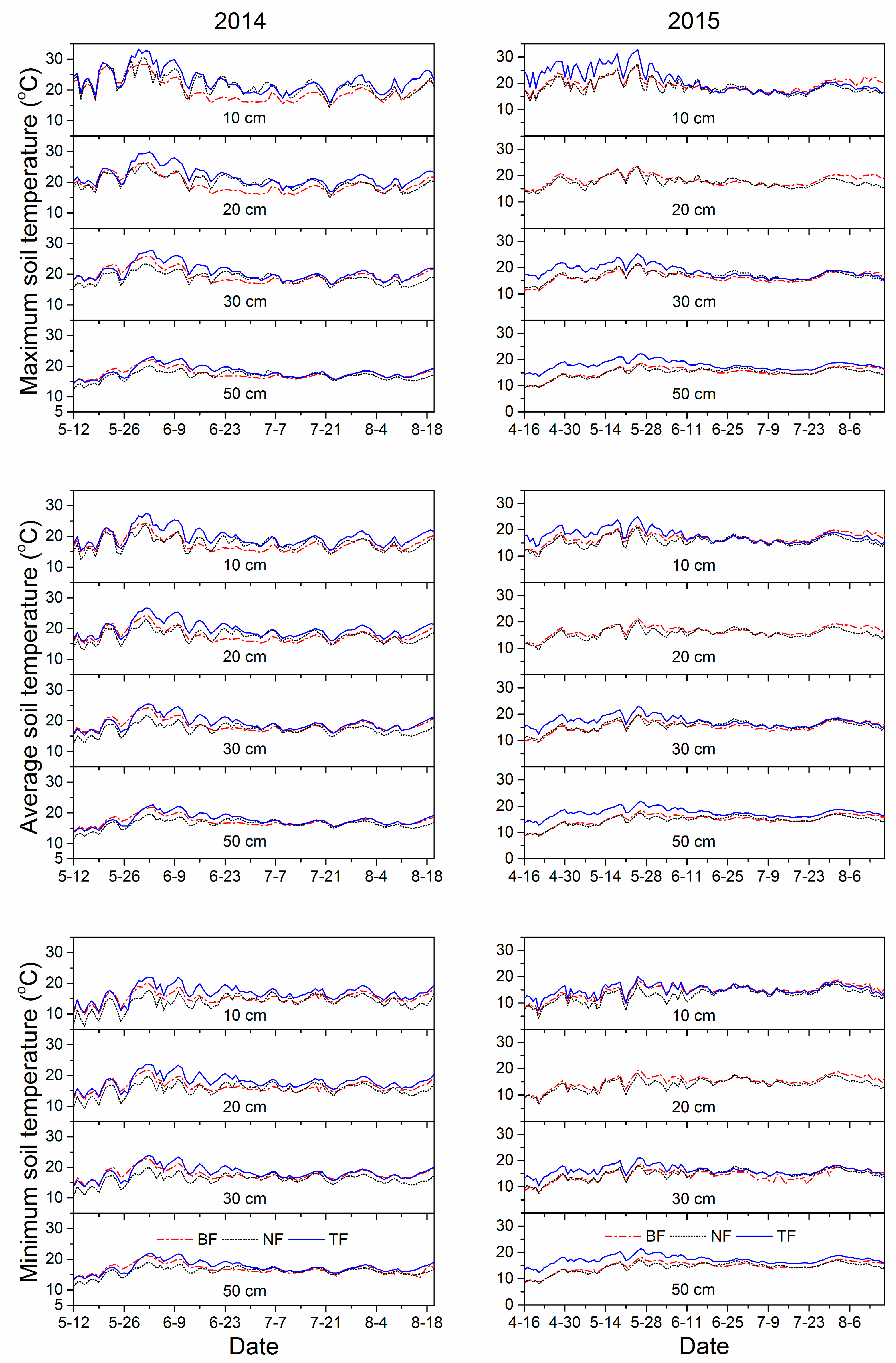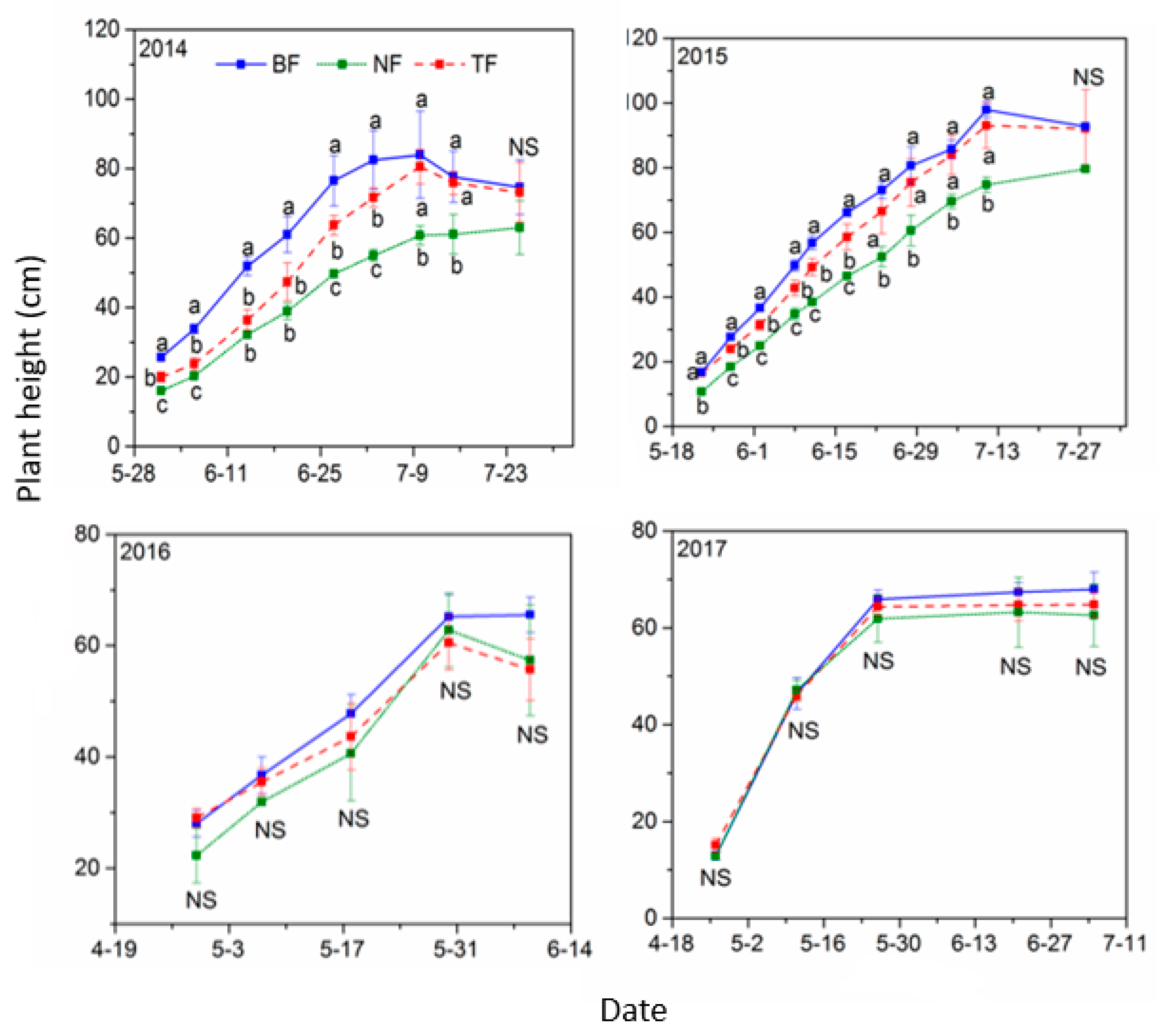Author Contributions
Conceptualization, Y.Z. and F.W.; methodology, R.F., W.N. and Y.Z.; software, Y.Z.; validation, Y.Z.; formal analysis, Y.Z.; investigation, R.F., W.N. and Y.Z.; resources, R.F., W.N. and Y.Z.; data curation, Y.Z.; writing—original draft preparation, Y.Z.; writing—review and editing, Y.Z., F.W. and S.F.; visualization, Y.Z.; supervision, F.W. and S.F.; project administration, Y.Z. and F.W.; funding acquisition, Y.Z. and F.W. All authors have read and agreed to the published version of the manuscript.
Figure 1.
Seasonal variations of the daily average solar radiation (Rs) in 2014–2016. Note: The data of solar radiation in 2017 was missed because of equipment failure.
Figure 1.
Seasonal variations of the daily average solar radiation (Rs) in 2014–2016. Note: The data of solar radiation in 2017 was missed because of equipment failure.
Figure 2.
Seasonal variations of the daily maximum net radiation (Rn), daily average net radiation (Rn), and daily minimum net radiation (Rn) for different mulch treatments: black film (BF), no film (NF), and transparent film (TF) in 2014–2017.
Figure 2.
Seasonal variations of the daily maximum net radiation (Rn), daily average net radiation (Rn), and daily minimum net radiation (Rn) for different mulch treatments: black film (BF), no film (NF), and transparent film (TF) in 2014–2017.
Figure 3.
Seasonal variations of the daily maximum soil heat flux (Gmax), daily average soil heat flux (Gavg), and daily minimum soil heat flux (Gmin) at 5 cm depth in the top of the beds for different mulch treatments: black film (BF), no film (NF), and transparent film (TF) in 2014–2017.
Figure 3.
Seasonal variations of the daily maximum soil heat flux (Gmax), daily average soil heat flux (Gavg), and daily minimum soil heat flux (Gmin) at 5 cm depth in the top of the beds for different mulch treatments: black film (BF), no film (NF), and transparent film (TF) in 2014–2017.
Figure 4.
Seasonal variations of the daily maximum soil temperature, daily average soil temperature, and daily minimum soil temperature at 10–50 cm soil depths for different mulch treatments: black film (BF), no film (NF), and transparent film (TF) in 2014 and 2015.The soil temperature at 20 cm soil depth in 2015 was not shown because of data anomalies.
Figure 4.
Seasonal variations of the daily maximum soil temperature, daily average soil temperature, and daily minimum soil temperature at 10–50 cm soil depths for different mulch treatments: black film (BF), no film (NF), and transparent film (TF) in 2014 and 2015.The soil temperature at 20 cm soil depth in 2015 was not shown because of data anomalies.
Figure 5.
Seasonal variations of the daily maximum soil temperature, daily average soil temperature, and daily minimum soil temperature at 10–50 cm soil depths for different mulch treatments: black film (BF), no film (NF), and transparent film (TF) in 2016 and 2017.
Figure 5.
Seasonal variations of the daily maximum soil temperature, daily average soil temperature, and daily minimum soil temperature at 10–50 cm soil depths for different mulch treatments: black film (BF), no film (NF), and transparent film (TF) in 2016 and 2017.
Figure 6.
Plant height of potatoes grown with black film (BF), no film (NF), and transparent film (TF) in 2014–2017. (Graphs of plant heights in 2014 and 2015 were according to Zhang et al., 2017b). Note: “NS” meant values of different treatments were not significantly different by F-test (p > 0.05).
Figure 6.
Plant height of potatoes grown with black film (BF), no film (NF), and transparent film (TF) in 2014–2017. (Graphs of plant heights in 2014 and 2015 were according to Zhang et al., 2017b). Note: “NS” meant values of different treatments were not significantly different by F-test (p > 0.05).
Table 1.
The net radiation (Rn) (daily maximum Rn, daily average Rn, and daily minimum Rn) differences between different treatments: black film (BF), no film (NF), and transparent film (TF) in the whole growth season and the early 30 days after potato growing in 2014–2017.
Table 1.
The net radiation (Rn) (daily maximum Rn, daily average Rn, and daily minimum Rn) differences between different treatments: black film (BF), no film (NF), and transparent film (TF) in the whole growth season and the early 30 days after potato growing in 2014–2017.
| Stage | Year | TF-NF | BF-NF | TF-BF |
|---|
| Max. | Avg. | Min. | Max. | Avg. | Min. | Max. | Avg. | Min. |
|---|
| Whole growth season | 2014 | −4.7 | −4.4 | −3.4 | 23.8 | 5.5 | −0.2 | −28.5 | −9.9 | −3.3 |
| 2015 | −20.1 | −8.4 | −4.2 | 31.1 | 6.4 | −0.9 | −51.2 | −14.8 | −3.3 |
| 2016 | −17.2 | −4.6 | 3.5 | 33.7 | 9.2 | 6.4 | −50.9 | −13.8 | −2.9 |
| 2017 | 8.7 | 3.0 | 1.3 | 53.1 | 14.0 | 1.7 | −44.5 | −11.0 | −0.5 |
| Early 30 days | 2014 | −19.1 | −12.8 | −8.3 | 51.0 | 10.3 | −5.2 | −70.1 | −23.0 | −3.1 |
| 2015 | −50.9 | −22.0 | −9.0 | 53.9 | 11.3 | −1.3 | −104.8 | −33.3 | −7.7 |
| 2016 | −32.4 | −10.2 | 0.2 | 60.0 | 15.2 | 4.5 | −92.5 | −25.5 | −4.3 |
| 2017 | 39.0 | 11.1 | 1.6 | 103.1 | 26.7 | 5.1 | −64.2 | −15.6 | −3.5 |
Table 2.
The soil heat flux (G) (daily maximum G, daily average G, and daily minimum G) differences between different treatments: black film (BF), no film (NF), and transparent film (TF) at 10 cm soil depth in the whole growth season and the early 30 days after potato growing in 2014–2017.
Table 2.
The soil heat flux (G) (daily maximum G, daily average G, and daily minimum G) differences between different treatments: black film (BF), no film (NF), and transparent film (TF) at 10 cm soil depth in the whole growth season and the early 30 days after potato growing in 2014–2017.
| Stage | Year | TF-NF | BF-NF | TF-BF |
|---|
| Max. | Avg. | Min. | Max. | Avg. | Min. | Max. | Avg. | Min. |
|---|
| Whole growth season | 2014 | 45.9 | 6.5 | −10.4 | −8.5 | 0.3 | 5.5 | 54.4 | 6.2 | −15.9 |
| 2015 | 9.7 | 1.4 | 0.9 | −7.4 | 4.1 | 10.9 | 17.1 | −2.8 | −10.0 |
| 2016 | 9.8 | 3.2 | 1.4 | 5.6 | 2.3 | 1.4 | 4.2 | 0.9 | −0.1 |
| 2017 | 19.1 | 5.4 | 2.2 | 1.0 | 3.4 | 6.4 | 18.1 | 2.0 | −4.2 |
| Early 30 days | 2014 | 62.7 | 10.7 | −14.6 | −23.4 | −1.5 | 11.1 | 86.1 | 12.2 | −25.7 |
| 2015 | 69.7 | 5.8 | −18.3 | 21.0 | 7.8 | −0.7 | 48.6 | −1.9 | −17.6 |
| 2016 | 10.4 | 3.8 | 2.0 | 6.1 | 1.5 | −0.5 | 4.3 | 2.3 | 2.5 |
| 2017 | 18.8 | 5.9 | 2.5 | −15.5 | −0.1 | 8.3 | 34.3 | 6.0 | −5.8 |
Table 3.
The soil temperature (T) (daily maximum T, daily average T, and daily minimum T) differences between different treatments: black film (BF), no film (NF), and transparent film (TF) at 10–50 cm soil depths in the whole growth season in 2014–2017.
Table 3.
The soil temperature (T) (daily maximum T, daily average T, and daily minimum T) differences between different treatments: black film (BF), no film (NF), and transparent film (TF) at 10–50 cm soil depths in the whole growth season in 2014–2017.
| Year | Maximum (TF-NF) | Average (TF-NF) | Minimum (TF-NF) |
|---|
| 10 cm | 20 cm | 30 cm | 50 cm | 10 cm | 20 cm | 30 cm | 50 cm | 10 cm | 20 cm | 30 cm | 50 cm |
|---|
| 2014 | 1.4 | 1.8 | 1.9 | 1.2 | 2.1 | 2.1 | 2.0 | 1.3 | 2.8 | 2.5 | 2.1 | 1.3 |
| 2015 | 2.5 | - | 1.6 | 2.9 | 2.2 | - | 1.6 | 2.9 | 2.0 | - | 1.5 | 2.8 |
| 2016 | 0.8 | 2.1 | 1.5 | 2.0 | 1.3 | 2.2 | 1.5 | 2.0 | 1.8 | 2.3 | 1.5 | 2.0 |
| 2017 | 1.4 | 1.5 | 0.8 | 1.1 | 0.9 | 1.2 | 0.8 | 1.1 | 0.6 | 1.0 | 0.8 | 1.1 |
| Average | 1.5 | 1.8 | 1.4 | 1.8 | 1.6 | 1.8 | 1.5 | 1.8 | 1.8 | 1.9 | 1.5 | 1.8 |
| | Maximum (BF-NF) | Average (BF-NF) | Minimum (BF-NF) |
| | 10 cm | 20 cm | 30 cm | 50 cm | 10 cm | 20 cm | 30 cm | 50 cm | 10 cm | 20 cm | 30 cm | 50 cm |
| 2014 | −1.7 | −0.7 | 0.8 | 0.7 | −0.1 | 0.2 | 1.3 | 0.8 | 1.3 | 0.9 | 1.6 | 0.7 |
| 2015 | 0.9 | 0.9 | −0.5 | 0.3 | 1.3 | 1.0 | −0.3 | 0.3 | 1.6 | 1.2 | −0.4 | 0.4 |
| 2016 | −0.8 | 1.1 | 0.1 | 0.5 | −0.2 | 1.3 | 0.2 | 0.5 | 0.3 | 1.6 | 0.2 | 0.6 |
| 2017 | 0.5 | 1.6 | 0.2 | 0.5 | 0.5 | 1.7 | 0.2 | 0.5 | 0.4 | 1.7 | 0.2 | 0.5 |
| Average | −0.3 | 0.7 | 0.1 | 0.5 | 0.4 | 1.0 | 0.3 | 0.5 | 0.9 | 1.4 | 0.4 | 0.5 |
| | Maximum (TF-BF) | Average (TF-BF) | Minimum (TF-BF) |
| | 10 cm | 20 cm | 30 cm | 50 cm | 10 cm | 20 cm | 30 cm | 50 cm | 10 cm | 20 cm | 30 cm | 50 cm |
| 2014 | 3.1 | 2.4 | 1.1 | 0.5 | 2.2 | 2.0 | 0.7 | 0.5 | 1.5 | 1.6 | 0.5 | 0.6 |
| 2015 | 1.6 | - | 2.1 | 2.6 | 0.9 | - | 1.9 | 2.5 | 0.4 | - | 1.9 | 2.5 |
| 2016 | 1.6 | 1.0 | 1.4 | 1.5 | 1.5 | 0.8 | 1.4 | 1.5 | 1.4 | 0.7 | 1.3 | 1.5 |
| 2017 | 0.9 | −0.1 | 0.7 | 0.6 | 0.4 | −0.4 | 0.6 | 0.6 | 0.2 | −0.7 | 0.6 | 0.6 |
| Average | 1.8 | 1.1 | 1.3 | 1.3 | 1.3 | 0.8 | 1.2 | 1.3 | 0.9 | 0.5 | 1.1 | 1.3 |
Table 4.
The soil temperature (T) (daily maximum T, daily average T, and daily minimum T) differences between different treatments: black film (BF), no film (NF), and transparent film (TF) at 10 cm soil depth during the early 30 days after potato growth in 2014–2017.
Table 4.
The soil temperature (T) (daily maximum T, daily average T, and daily minimum T) differences between different treatments: black film (BF), no film (NF), and transparent film (TF) at 10 cm soil depth during the early 30 days after potato growth in 2014–2017.
| Year | Maximum (TF-NF) | Average (TF-NF) | Minimum (TF-NF) |
|---|
| 10 cm | 20 cm | 30 cm | 50 cm | 10 cm | 20 cm | 30 cm | 50 cm | 10 cm | 20 cm | 30 cm | 50 cm |
|---|
| 2014 | 1.9 | 2.6 | 2.8 | 1.9 | 2.9 | 3.0 | 2.9 | 1.9 | 3.9 | 3.4 | 2.9 | 2.0 |
| 2015 | 6.0 | - | 4.0 | 4.6 | 4.4 | - | 3.5 | 4.5 | 3.2 | - | 3.2 | 4.4 |
| 2016 | 1.2 | 2.5 | 1.7 | 2.0 | 1.7 | 2.5 | 1.8 | 2.1 | 2.2 | 2.6 | 1.7 | 2.1 |
| 2017 | 3.7 | 3.0 | 1.6 | 1.6 | 2.4 | 2.3 | 1.5 | 1.6 | 1.5 | 1.8 | 1.4 | 1.6 |
| Average | 3.2 | 2.7 | 2.5 | 2.5 | 2.8 | 2.6 | 2.4 | 2.5 | 2.7 | 2.6 | 2.3 | 2.5 |
| | Maximum (BF-NF) | Average (BF-NF) | Minimum (BF-NF) |
| | 10 cm | 20 cm | 30 cm | 50 cm | 10 cm | 20 cm | 30 cm | 50 cm | 10 cm | 20 cm | 30 cm | 50 cm |
| 2014 | −0.5 | 0.8 | 2.3 | 2.0 | 1.3 | 1.6 | 2.7 | 2.1 | 2.8 | 2.3 | 3.0 | 2.2 |
| 2015 | 0.9 | 0.9 | −0.5 | 0.3 | 1.1 | 0.9 | −0.4 | 0.3 | 1.2 | 1.0 | −0.3 | 0.3 |
| 2016 | −1.2 | 0.7 | −0.1 | 0.4 | −0.4 | 1.0 | 0.0 | 0.4 | 0.2 | 1.4 | 0.1 | 0.4 |
| 2017 | −0.1 | 1.2 | −0.2 | 0.3 | 0.2 | 1.4 | 0.0 | 0.3 | 0.4 | 1.5 | 0.0 | 0.3 |
| Average | −0.2 | 0.9 | 0.4 | 0.8 | 0.5 | 1.2 | 0.6 | 0.8 | 1.2 | 1.6 | 0.7 | 0.8 |
| | Maximum (TF-BF) | Average (TF-BF) | Minimum (TF-BF) |
| | 10 cm | 20 cm | 30 cm | 50 cm | 10 cm | 20 cm | 30 cm | 50 cm | 10 cm | 20 cm | 30 cm | 50 cm |
| 2014 | 2.4 | 1.8 | 0.5 | −0.1 | 1.6 | 1.4 | 0.1 | −0.2 | 1.0 | 1.1 | 0.0 | −0.2 |
| 2015 | 5.2 | - | 4.5 | 4.3 | 3.3 | - | 3.9 | 4.2 | 1.9 | - | 3.5 | 4.1 |
| 2016 | 2.4 | 1.8 | 1.8 | 1.6 | 2.1 | 1.5 | 1.7 | 1.7 | 2.0 | 1.2 | 1.7 | 1.6 |
| 2017 | 3.8 | 1.8 | 1.8 | 1.3 | 2.2 | 0.9 | 1.5 | 1.3 | 1.1 | 0.2 | 1.4 | 1.3 |
| Average | 3.4 | 1.8 | 2.1 | 1.8 | 2.3 | 1.3 | 1.8 | 1.7 | 1.5 | 0.8 | 1.6 | 1.7 |
Table 5.
Potato tuber fresh weight of 10 plants sampled from black film (BF), no film (NF), and transparent film (TF) treatment in 2014–2017.
Table 5.
Potato tuber fresh weight of 10 plants sampled from black film (BF), no film (NF), and transparent film (TF) treatment in 2014–2017.
| Treatment | W ≥ 300 g | 300 g > W ≥ 100 g | W < 100 g | Total |
|---|
| 2014 | | | | | | | | | | | | |
| BF | 7241 | (465) | a * | 8061 | (924) | a * | 1061 | (217) | a * | 16362 | (620) | a * |
| NF | 5142 | (808) | b | 6510 | (1157) | a | 1447 | (188) | a | 13099 | (1629) | a |
| TF | 5646 | (766) | b | 7764 | (1930) | a | 1658 | (288) | a | 15069 | (1931) | a |
| 2015 | | | | | | | | | | | | |
| BF | 10789 | (2343) | a * | 8807 | (1212) | a * | 1081 | (418) | a * | 20677 | (981) | a * |
| NF | 6759 | (1640) | a | 6702 | (540) | a | 1804 | (636) | a | 15266 | (1650) | a |
| TF | 12050 | (2508) | a | 7775 | (807) | a | 637 | (340) | a | 20462 | (2950) | a |
| 2016 | | | | | | | | | | | | |
| BF | 5239 | (865) | a * | 6223 | (1830) | a * | 854 | (135) | a * | 12316 | (1285) | a * |
| NF | 3392 | (2764) | a | 5850 | (1068) | a | 811 | (72) | a | 10053 | (2090) | a |
| TF | 7015 | (1678) | a | 5022 | (1376) | a | 433 | (229) | b | 12470 | (514) | a |
| 2017 | | | | | | | | | | | | |
| BF | 15451 | (699) | a * | 15552 | (375) | a * | 2123 | (577) | a * | 33125 | (1482) | a * |
| NF | 17510 | (5329) | a | 14110 | (2797) | a | 2615 | (592) | a | 34235 | (3088) | a |
| TF | 19051 | (2479) | a | 13014 | (2760) | a | 1943 | (561) | a | 34007 | (1094) | a |
Table 6.
Potato tuber number of 10 plants sampled from black film (BF), no film (NF), and transparent film (TF) treatment in 2014–2017.
Table 6.
Potato tuber number of 10 plants sampled from black film (BF), no film (NF), and transparent film (TF) treatment in 2014–2017.
| Treatment | W ≥ 300 g | 300 g > W ≥ 100 g | W < 100 g | Total |
|---|
| 2014 | | | | | | | | | | | | |
| BF | 17 | (2) | a * | 41 | (3) | a * | 19 | (4) | b * | 78 | (4) | b * |
| NF | 13 | (2) | b | 36 | (5) | a | 28 | (6) | a | 77 | (2) | b |
| TF | 14 | (1) | b | 45 | (8) | a | 35 | (3) | a | 93 | (6) | a |
| 2015 | | | | | | | | | | | | |
| BF | 25 | (4) | a * | 45 | (7) | a * | 19 | (8) | a * | 90 | (10) | a * |
| NF | 15 | (3) | b | 38 | (1) | a | 37 | (14) | a | 90 | (11) | a |
| TF | 26 | (6) | a | 40 | (7) | a | 13 | (8) | a | 79 | (18) | a |
| 2016 | | | | | | | | | | | | |
| BF | 13 | (3) | a * | 32 | (8) | a * | 14 | (2) | a * | 59 | (3) | a * |
| NF | 9 | (7) | a | 30 | (6) | a | 13 | (1) | a | 51 | (4) | a |
| TF | 17 | (4) | a | 26 | (7) | a | 7 | (3) | b | 50 | (7) | a |
| 2017 | | | | | | | | | | | | |
| BF | 38 | (1) | a * | 78 | (3) | a * | 48 | (18) | a * | 163 | (21) | a * |
| NF | 42 | (15) | a | 74 | (15) | a | 60 | (12) | a | 176 | (8) | a |
| TF | 46 | (5) | a | 68 | (13) | a | 52 | (14) | a | 166 | (12) | a |
Table 7.
Potato tuber yield, irrigation, and irrigation water use efficiency (IWUE) of black film (BF), no film (NF), and transparent film (TF) treatment in 2014–2017.
Table 7.
Potato tuber yield, irrigation, and irrigation water use efficiency (IWUE) of black film (BF), no film (NF), and transparent film (TF) treatment in 2014–2017.
| Treatment | Yield (kg/hm2) | Irrigation (mm) | IWUE (kg/hm2/mm) |
|---|
| 2014 | | | | | |
| BF | 62,353 | a * | 317 | 197 | ab * |
| NF | 51,206 | b | 277 | 185 | b |
| TF | 63,031 | a | 293 | 215 | a |
| 2015 | | | | | |
| BF | 82,704 | a * | 366 | 226 | a * |
| NF | 62,191 | b | 392 | 159 | b |
| TF | 81,968 | a | 344 | 238 | a |
| 2016 | | | | | |
| BF | 51,317 | a * | 180 | 285 | a * |
| NF | 41,888 | a | 144 | 291 | a |
| TF | 51,957 | a | 144 | 361 | a |
| 2017 | | | | | |
| BF | 59,426 | a * | 276 | 215 | a * |
| NF | 61,913 | a | 260 | 238 | a |
| TF | 59,389 | a | 276 | 215 | a |
